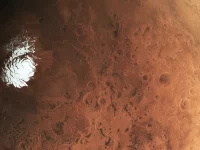Elon Musk walks out to applause for his September 2015 interview on “The Late Show with Stephen Colbert.” After exchanging pleasantries, Colbert asks Musk about his fascination with our closest solar neighbor: “You sincerely think that we should go to Mars…Why do we want to go to Mars? It’s uninhabitable.”
“It is a fixer-upper of a planet,” Musk responds, eliciting laughter from the audience. “At first you’re going to have to live in transparent domes, but eventually you can transform Mars into an Earth-like planet.”
The concept Musk is referring to — transforming the environment of another planet to make it hospitable for human life — is known as “terraforming” and was first coined by science fiction writer Jack Williamson in 1942. Terraforming Mars would require raising its atmospheric pressure from 0.006 atmospheres to Earth’s 1 atmosphere and increasing the temperature by about 60 degrees Celsius. Many methods for achieving this have been proposed, some as implausible as multi-kilometer wide space mirrors to reflect extra sunlight onto the planet and bioengineered extra-tough Martian plants to develop the atmosphere. The most discussed and scientifically realistic proposal involves extracting carbon from the surface and releasing it into the atmosphere to create a greenhouse effect (the same mechanism driving climate change on Earth). The concept has steadily grown in popularity, exploding in recent years. It has gained an almost cult-like following, assisted by Musk and other advocates for a human mission to Mars — including aerospace engineer and author Robert Zubrin and director Chris McKay, best known for “The LEGO Batman Movie.”
It has gained an almost cult-like following, assisted by Musk and other advocates for a human mission to Mars — including aerospace engineer and author Robert Zubrin and director Chris McKay, best known for “The LEGO Batman Movie.”
Colbert presses Musk. “How would you warm Mars up? You know it’s a long way away from the Sun.”
Musk chuckles. “The fast way is [to] drop thermonuclear weapons over the poles.”
“You’re a supervillain!” Colbert retorts, poking at the absurdity of the statement. Nevertheless, the concept has been seriously considered by scientists and put through the rigor of the scientific process. So, could it work?
“No, it will not work,” says Dr. Bruce Jakosky, a planetary scientist and the principal investigator for NASA’s MAVEN Mars Orbiter, focused on studying the Martian Atmosphere. “Nuking the poles would release any CO₂ that is trapped there back into the atmosphere… This would… not produce any significant greenhouse warming,” Jakosky told NU Sci. He authored a 2018 paper taking inventory of all the accessible carbon reservoirs on Mars that could be used in a terraforming process. The list is exhaustive, including carbon that has been absorbed by Mars’s iconic red surface material, carbon molecules buried deep in rich mineral plains, and carbon frozen in the polar ice. However, releasing all this carbon would be a virtually impossible task, likely requiring future Martians to strip-mine and scorch practically the entire surface and detonate explosives or nuclear weapons at the poles, yet all of this would only increase the pressure to, at most, roughly 20 percent of Earth’s.
releasing all this carbon would be a virtually impossible task, likely requiring future Martians to strip-mine and scorch practically the entire surface and detonate explosives or nuclear weapons at the poles, yet all of this would only increase the pressure to, at most, roughly 20 percent of Earth’s.
When asked if he believed there was consensus within the scientific community supporting his conclusion, Jakosky said, “Yes, but consensus does not imply unanimity,” joking, “I suspect that Chris McKay might disagree with my conclusions,” referring to the pro-terraforming “LEGO Batman” director. While scientists agree that terraformation will not be possible without a paradigm shift in humanity’s technological capability, which NASA publicly agreed with in a 2018 press statement, there is a large portion of space and science enthusiasts who reject this consensus.
These individuals find community in the Facebook group for Zubrin’s space exploration advocacy organization “The Mars Society.” Members frequently share terraforming artwork, affirming articles, and their own terraformation ideas — sometimes done so in personal PDF files masquerading as scientific papers. These eccentric ideas range from deliberately smashing asteroids into Mars to funneling particles from space into the atmosphere using a colossal orbiting magnetic ring the size of New York City. Users post and ridicule the 2018 NASA press release regularly — almost three years after its publication.
Terraformation is, at its heart, a product of science fiction and not a rigorous scientific concept, and there is a real risk in conflating a science-fiction thought experiment with reality. Jakosky warned, “I think it’s dangerous to take seriously the idea that Mars can serve as a ‘backup’ planet in case the Earth becomes uninhabitable. If we believe that, it’s too easy to fall into the trap of not taking care of the Earth… It’ll always be easier to fix our climate than to change the Martian climate into one that is suitable for us.”
Image Source: Pixabay





